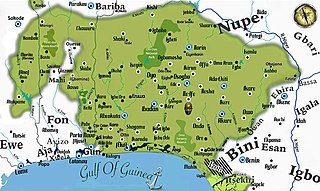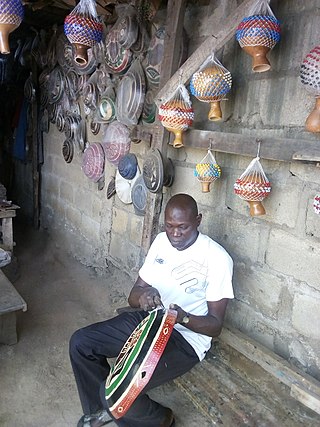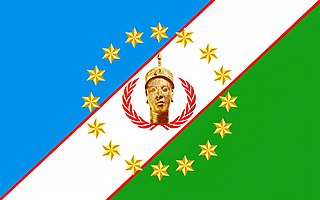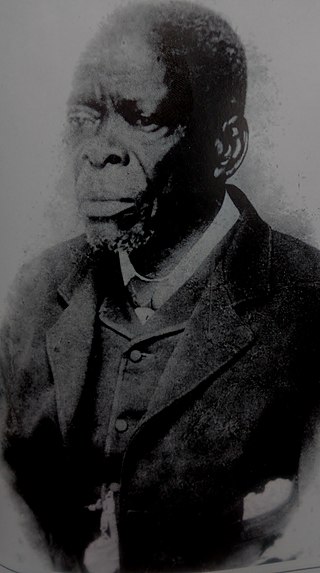
Yorubaland is the homeland and cultural region of the Yoruba people in West Africa. It spans the modern-day countries of Nigeria, Togo and Benin, and covers a total land area of 142,114 km2 (54,871 sq mi). Of this land area, 106,016 km2 (74.6%) lies within Nigeria, 18.9% in Benin, and the remaining 6.5% is in Togo. Prior to European colonization, a portion of this area was known as Yoruba country. The geo-cultural space contains an estimated 55 million people, the majority of this population being ethnic Yoruba.

The Oyo Empire was a Yoruba empire in West Africa. It was located in present-day southern Benin and western Nigeria. The empire grew to become the largest Yoruba-speaking state through the organizational and administrative efforts of the Yoruba people, trade, as well as the military use of cavalry. The Oyo Empire was one of the most politically important states in Western Africa from the mid-17th to the late 18th century and held sway not only over most of the other kingdoms in Yorubaland, but also over nearby African states, notably the Fon Kingdom of Dahomey in the modern Republic of Benin on its west.

The Rev. Samuel Johnson was an Anglican priest and historian of the Yoruba.
Abiodun was an 18th-century alaafin, or king, of the Oyo people in what is now Nigeria.

Alaafin, or The custodian of the Palace in the Yoruba language, is the title of the king of the medieval Oyo empire and present-day Oyo town of West Africa. It is the particular title of the Oba (king) of the Oyo. It is sometimes translated as "emperor" in the context of ruler of empire. He ruled the old Oyo Empire, which extended from the present-day Benin republic to Nigeria, originating from states in the South East and West to the North. The people under him are called Yoruba people and spoke the Yoruba Language.
Chief Oluyole was a distinguished, dominating army commander from Oyo. He rose to fame as Bashorun, a title he subsequently made famous, and was one of the leaders who contributed immensely to the military and economic development of Ibadan during the city's formative years, a period which had its share of tumult and uncertainty.

Oyo is a city in Oyo State, Nigeria. It was founded as the capital of the remnant of the historic Oyo empire in the 1830s, and is known to its people as 'New Oyo' to distinguish it from the former capital to the north, 'Old Oyo' (Ọ̀yọ́-Ilé), which had been deserted as a result of the Yoruba Revolutionary Wars. Its inhabitants are mostly of the Yoruba people, and its ruler is the Alaafin of Oyo.
Bashorun Gaha was a notable nobleman and leader of the military in the old Oyo Empire during the 18th century. From 1650 to 1750, Oyo Empire was at the pinnacle of its greatness, peace, prosperity and wealth. The Empire had expanded to the utmost part covering the river Niger in the north; part of Tapa and Bariba kingdoms in the East of the lower Niger; towards the South by the seacoast and the West including Popos and Dahomey. Thousands of provincial officials were appointed to administer all the conquered kingdoms and report to the Alafin who glory in his majesty and power. Women, men, young and old sang his praises. Then internal struggles for power began the rapid acceleration of the Empire disintegration and total collapse.

The documented history begins when Oranyan came to rule the Oyo Empire, which became dominant in the early 17th century. The older traditions of the formerly dominant Ile-Ife kingdom are largely oral.

The Yoruba people are a West African ethnic group who mainly inhabit parts of Nigeria, Benin, and Togo. The areas of these countries primarily inhabited by the Yoruba are often collectively referred to as Yorubaland. The Yoruba constitute more than 50 million people in Africa, are over a million outside the continent, and bear further representation among members of the African diaspora. The vast majority of the Yoruba population is today within the country of Nigeria, where they make up 20.7% of the country's population according to Ethnologue estimations, making them one of the largest ethnic groups in Africa. Most Yoruba people speak the Yoruba language, which is the Niger-Congo language with the largest number of native or L1 speakers.
Gbongan is a large town in Osun State, Nigeria. It is the headquarters of the Aiyedaade Local Government Area.
The Ilorin Emirate is a traditional state based in the city of Ilorin in Kwara State, Nigeria. It is largely populated by the Yoruba-speaking people, though the kingdom is a hybrid state due to the influence of the many other tribes that make up the city.

Fredrick Kúmókụn Adédeji Haastrup was born in the 19th century into the family of a member of the ancient Bilaro Royal house of Iléṣa. It is one of the four ruling families of Ileṣa and has been, since the reign of Owá Ọbọkun Atakumosa 900 years ago. After his reign, accession to the throne was passed, in turn, between his four sons, a system that continues to date: accession is rotated between four ruling families in Ijéṣaland. Following Kúmókụn's reign, the Bilárọ family adopted the name Ajímọkọ Haastrup. Whilst the Bilágbayọ adopted the surname Adesuyi.
Afonja of Ilorin was the "Are-Ona-Kakanfo", or chief military leader, of the Oyo Empire. Laderin, the great-grandfather of Afonja, was the founder of Ilorin city. He was succeeded by his son, Pasin, a powerful warrior who became a threat and target to, Basorun Gaha, because of his rising profile. He was driven into exile and killed. Alagbin, his son was made Baale. After the death of Alagbin, his son, Afonja, took over. These were the only four Yoruba baale in Ilorin.
Ọba Timi Abibu Sàngólámì (Ọ)Lágúnjú was a Yoruba monarch of the town of Ede, and leader in the 19th century. He was the first Muslim Timi that Ede produced, he also belonged to the first generation of Yoruba Muslims who held high political office in the pre-colonial era and who used their positions to enhance the growth of his town, Ede and his religion, Islam. Indeed, Abibu Lagunju was the second Muslim Oba in Yorubaland given the fact that he was already on the throne for a couple of years when, in November 1857, the American Baptist Missionary, Reverend W.H. Clarke, visited Ede.

The Oyo Mesi is the privy council of Oyo, a Yoruba traditional state in Southwestern Nigeria. It dates to the medieval period, when it served as the government of a powerful pre-colonial state that was known as the Oyo empire.
The Kiriji War, also known as the Ekiti–Parapo War, was a 16-year-long civil war between the subethnic kingdoms of the Yoruba people, specifically divided between the Western Yoruba, which was mainly the Ibadan and Oyo-speaking Yorubas, and the Eastern Yoruba, who were the Ekiti people, Ijesha, Ijebu people, and others.

Obadoke Latoosa Oyatoosa, but more commonly referred to as Latoosa, and later Mohammed Obadoke Latoosa, was a Yoruba General, Warlord, and Chief who was the Aare Ona Kakanfo of the Oyo Empire, the ruler of the self proclaimed Ibadan Empire, and the commander and leader of the Western forces of Ibadan during the Kiriji War from 1877 to his death in 1885.
Alaafin Atiba Atobatele was a king of the Oyo Empire. He was the son of King Abiodun of Oyo, and Eni-olufan from Akeitan.
Orile Ijaye is a small town located in Akinyele local government, Oyo state, Nigeria. It is about 18 miles from Ibadan, Oyo state capital. This town was re-inhabited in 1895, 32 years after it was destroyed due to an intra-ethnic and supremacy war with Ibadan; another military power at that time. In 1895, they named it Orile Ijaye from the original name, Ijaye. also meaning ijaye city-town.











